Tooth-billed pigeon
| Tooth-billed pigeon | |
|---|---|
 |
|
| Live specimen in 1901 | |
| Scientific classification | |
| Kingdom: | Animalia |
| Phylum: | Chordata |
| Class: | Aves |
| Order: | Columbiformes |
| Family: | Columbidae |
| Genus: |
Didunculus Peale, 1848 |
| Species: | D. strigirostris |
| Binomial name | |
|
Didunculus strigirostris (Jardine, 1845) |
|
The tooth-billed pigeon (Didunculus strigirostris), also known as the manumea, is a large pigeon found only in Samoa. It is the only living species of genus Didunculus. A related extinct species, the Tongan tooth-billed pigeon (Didunculus placopedetes), is only known from subfossil remains in several archeological sites in Tonga. The tooth-billed pigeon is the national bird of Samoa and featured on the 20 tālā bills and the 50 sene pieces of the 2008/2011 series.
The tooth-billed pigeon is a medium-sized, approximately 31 cm long, dark pigeon with reddish feet and red bare skin around the eye. The underparts, head and neck are greyish with a slight blue-green iridescence, and the tail, wings-coverts and tertials are rufous chestnut, while the remaining remiges are blackish. It has a large, curved, and hooked bright red bill with tooth-like projections on the lower mandible. Both sexes are similar, but the juvenile is duller with a browner head, with a black bill with only the base a pale orange.
The species was probably found in October or November 1839, by the United States' Exploring Expedition under Commander Wilkes. The discovery of the bird was announced by Hugh Edwin Strickland in September 1844 as being among the rarities obtained by Mr. Titian Peale, the naturalist of the expedition. The formal description was made by William Jardine (Ann. Nat. Hist. xvi. p. 175, plate 9), under the name of Gnathodon strigirostris, although that genus name was already in use for a mollusc.
It has no close living relative, but it has been shown to be genetically close to the dodo, and the genus name Didunculus means "little dodo". the English name of dodlet was suggested by Sir Richard Owen. The jaw and tongue structure, and the superficially parrotlike bill have suggested a relationship to the parrots, but these features have arisen from its specialised diet rather than any real relationship.
...
Wikipedia

